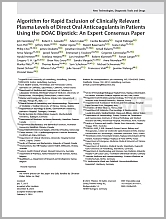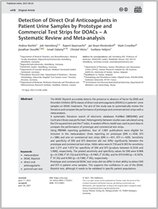
Resources
Here you can find publications and other resources related to the DOASENSE products.
Please note that our products are for health care professional use only!
(Make sure to scroll through the lists in the individual sections below)

Sie haben nur 10 Minuten Zeit?
Wenn jede Minute zählt,
dann lesen Sie unser zusammenfassendes
Whitepaper:
dann lesen Sie unser zusammenfassendes
Whitepaper:
(aktualisiert 05-2025)
A. Fundamental Publications
- Harenberg J, Gosselin RC, Cuker A, Becattini, Pabinger I, Poli S, Weitz JI, Ageno W, Bauersachs R, Ćelap I, Choi P, Douketis J, Douxfils J, Elalamy I, Fareed J, Falanga A, Favalor E, Gerotziafas GT, Herkner H, Hetjens S, Klamroth R, Heubner L, Langer F, Lip GYH, Mac Grory B, Margetić S, Merrelaar A, Pikta M, Renne' T, Schwameis M, Schulman S, Strbian D, Tafur A, Violi F, Vassart J, Walenga J, Weiss C:
Algorithm for rapid exclusion of clinically relevant plasma levels of DOACs in patients using the DOAC Dipstick. An expert consensus paper.Thromb Haemost 2024; 124(08): 770-777, DOI: 10.1055/a-2261-1811[download HERE]
- Walenga JM:
EDITORIAL -- Can We Improve on the Rapid Assessment of Clinically Relevant Levels of Direct Acting Oral Anticoagulants (DOAC)?
Clinical and Applied Thrombosis/Hemostasis, Volume 28: 1-2, 2022, DOI: 10.1177/10760296221096422
[Free open access download HERE]
- Harenberg J, Hetjens S, Weiss C:
Patients’ Plasma Activity of Heparin, low-Molecular-Weight Heparin or no Anticoagulants on Urine Based DOAC Test Strips
Clinical and Applied Thrombosis/Hemostasis, Volume 28: 1-4, 2022, DOI: 10.1177/10760296221083667
[Free open access download HERE] - Martini A, Harenberg J, Bauersachs R, Beyer-Westendorf J, Crowther M, Douxfils J, Elalamy I, Weiss C, Hetjens S:
Detection of Direct Oral Anticoagulants in Patient Urine Samples by Prototype and Commercial Test Strips for DOACs – A Systematic Review and Meta-analysis
TH Open 2021; 05(03): e438-e448
[Free open access download HERE]
- Harenberg J, Martini A, Du S, Krämer S, Weiss C, Hetjens S:
Performance Characteristics of DOAC Dipstick in Determining Direct Oral Anticoagulants in Urine
Clinical and Applied Thrombosis/Hemostasis, Volume 27: 1-6, 2021 [read HERE]
- Harenberg J, Beyer-Westendorf J, Crowther M, Douxfils J, Elalamy I, Verhamme P, Bauersachs R, Hetjens S, Weiss C:
Accuracy of a Rapid Diagnostic Test for the Presence of Direct Oral Factor Xa or Thrombin Inhibitors in Urine — A Multicenter Trial
Thromb Haemost 2020; 120(01): 132-140
[Free open access download HERE]
- Favaloro EJ, Lippi G:
The Pointy End of Point-of-Care Testing for Direct Oral Anticoagulants
Thromb Haemost 2020;120:11–13. [download editorial]
- Harenberg J, Schreiner H, Hetjens S, Weiss C:
Detecting Anti-IIa and Anti-Xa Direct Oral Anticoagulant (DOAC) Agents in Urine using a DOAC Dipstick.
Semin Thromb Hemost 2019; 45: 275–284
[Free open access download HERE]
- Harenberg J, Du S, Wehling M, Zolfaghari S, Weiss C, Krämer R, Walenga J:
Measurement of dabigatran, rivaroxaban and apixaban in samples of plasma, serum and urine, under real life conditions. An international study.
Clin Chem Lab Med. 2016 Feb 1; 54(2): 275-83
- Harenberg J, Du S, Krämer R, Weiss C, Krämer R, Wehling M:
Patients' serum and urine as easily accessible samples for the measurement of non-vitamin K antagonist oral anticoagulants.
Semin Thromb Hemost. 2015 Mar; 41(2): 228-36
- Harenberg J, Krämer S, Du S, Weiss C, Krämer R:
Concept of a point of care test to detect new oral anticoagulants in urine samples.
Thromb J. 2013 Aug 1; 11(1):15
B. Publications on Clinical Applications
- Julie Vassart, Alfonso Tafur, Marisa Durante, Anne-Yseult Boucher, Laure Morimont, Jeanine M. Walenga, Job Harenberg, Jonathan Douxfils:
The DOAC (direct oral anticoagulant) Dipstick reliably excludes residual FXa inhibitors levels in the preoperative setting
Thrombosis Research 239 (2024) 109023, DOI: 10.1016/j.thromres.2024.04.029
[Read HERE]
- Peter S Tan, Peter SW Park, Ross Cody, Tanya Frost, Bailey McNamara, Marija Borosak, Philip MC Choi:
Assessment of Direct Oral Anticoagulant Status Using the DOASENSE Dipstick in Thrombolysis Eligible Patients With Stroke: Proof-of-Concept Study
Stroke. 2023;54:00–00
[Read HERE]
- Loula Papageorgiou, Svetlana Hetjens, Jawed Fareed, Sanny Auge, Laetitia Tredler, Job Harenberg, Christel Weiss, Ismail Elalamy, Grigorios T. Gerotziafas:
Comparison of the DOAC Dipstick Test on Urine Samples With Chromogenic Substrate Methods on Plasma Samples in Outpatients Treated With Direct Oral Anticoagulants
Clinical and Applied Thrombosis/Hemostasis, Volume 29: 1-7, 2023, DOI: 10.1177/10760296231179684
[Read HERE]
- Merrelaar AE, Bögl MS, Buchtele N, Merrelaar M, Herkner H, Schoergenhofer C, Harenberg J, Douxfils J, Siriez R, Jilma B, Spiel AO, Schwameis M:
Performance of a Qualitative Point-of-Care Strip Test to Detect DOAC Exposure at the Emergency Department: A Cohort-Type Cross-Sectional Diagnostic Accuracy Study
Thromb Haemost 2022, DOI: 10.1055/s-0042-1750327
[Free open access download HERE]
- Margetić S, Ćelap I, Lovrenčić Huzjan A, Bosnar Puretić M, Šupraha Goreta S, Čajević Glojnarić A, Delić Brkljačić D, Mioč P, Harenberg J, Hetjens S, Weiss C:
DOAC Dipstick Testing Can Reliably Exclude the Presence of Clinically Relevant DOAC Concentrations in Circulation
Thromb Haemost 2022, DOI: 10.1055/a-1753-2748
[Free open access download HERE]
- Örd L, Marandi T, Märk M, Raidjuk L, Kostjuk J, Banys V, Krause K, Pikta M:
Evaluation of DOAC Dipstick Test for Detecting Direct Oral Anticoagulants in Urine Compared with a Clinically Relevant Plasma Threshold Concentration
Clinical and Applied Thrombosis/Hemostasis, 2022, Volume 28: 1-8
[Read HERE]
- Niederdöckl J, Buchtele N, Schwameis M, Domanovits H:
Modern diagnostics in emergency medicine
Wien Klin Wochenschr 133, 249–266 (2021). [download HERE and refer to page 253]
C. Guidelines etc.
- Recent guideline from the British Society of Haematology on the measurement of direct oral anti-coagulants lists the DOASENSE point-of-care test
Br J Haematol. 2024;00:1–17.
[download HERE]
- DOASENSE test included in new Guideline published by the European Society of Anaesthesiology and Intensive CareEur J Anaesthesiol 2024; 41:327–350.
[read more]
- Algorithm for rapid exclusion of clinically relevant plasma levels of DOACs in patients using the DOAC Dipstick. An expert consensus paper.Thromb Haemost 2024, DOI: 10.1055/a-2261-1811
- DOASENSE is the recommended Point Of Care Test for the prescription of Andexanet alpha (ONDEXXYA) in Tuscany (Italy)
[Read more]
- Germany’s Federal Joint Committee (Gemeinsamer Bundesausschuss G-BA) decided to expand the guideline for care of hip fractures to include regulations on testing for DOACs.
The G-BA also mentions the DOASENSE DOAC Dipstick as suitable DOAC test:
"For all four common DOAKs, a urine dipstick test with colour coding is also available, which indicates with very high reliability whether relevant active substance concentrations are present in the urine".
:
Richtlinie zur Versorgung der hüftgelenknahen Femurfraktur: Ergänzung der Regelungen zur SOP „Umgang mit gerinnungshemmender Medikation“ [read HERE in German]
- Value of rapid POC testing for DOACs using the DOASENSE test is mentioned in the 2021 Australasian Anaesthesia Blue Book.
According to the Blue Book, the DOASENSE urine test offers several advantages over plasma drug levels: It is quick, takes only 10 minutes, and accurate. It is less invasive than plasma sampling, and overcomes difficulties in patients that are difficult to draw blood from.
[Download the Blue Book and refer to page 150]
- National Institute for Health and Care Excellence (NICE):
DOAC Dipstick for detecting direct oral anticoagulants
Medtech innovation briefing [MIB248], Published: 02 February 2021 [read HERE]
- ANTICOAGULATION FORUMReversal and Treatment Strategies for DOAC-Related Bleeding
Updated 01-2021 [read HERE]
- Perifanis V, Neokleous N, Tsakiris D:
Update on laboratory testing and hemostasis assessment in patients receiving direct oral anticoagulants (DOACs)
Thrombosis Update 5 (2021) 100084. https://doi.org/10.1016/j.tru.2021.100084 [read HERE] - Robert C. Gosselin, Dorothy M. Adcock, Jonathan Douxfils:
An update on laboratory assessment for direct oral anticoagulants (DOACs)
Int J Lab Hematol. 2019;41(Suppl. 1):33–39 [article]
- Robert C. Gosselin, Dorothy M. Adcock, Shannon M. Bates, Jonathan Douxfils, Emmanuel J. Favaloro, Isabelle Gouin-Thibault, Cecilia Guillermo, Yohko Kawai, Edelgard Lindhoff-Last, Steve Kitchen:
International Council for Standardization in Haematology (ICSH) Recommendations for Laboratory Measurement of Direct Oral Anticoagulants
Thromb Haemost 2018; 118(3): 437-450 [ICSH Guidelines]
D. Congress Presentations
- Tan S, Park P, Cody R, Frost T, McNamara B, Borosak M, Choi P:
Stroke on DOAC – A proof of concept study using the point of care DOASENSE dipstick to guide thrombolysis decision making in patients prescribed a direct oral anticoagulant
International Journal of Stroke 2022, Vol. 17(2S) 35, abstract 58
[download HERE and refer page 35 for abstract 58]
- Ćelap I, Margetic S, Perisa J, Razum M, Šupraha Goreta S, Čajevic-Glojnaric A:
Exclusion of relevant concentrations of direct oral anticoagulants in blood by DOAC Dipstick – proposal of a diagnostic algorithm for improvement of clinical decision-making in emergencies
ISTH 2022, Poster PB1064 [view poster]
- Papageorgiou L, Harenberg J, Auge S, Tredler L, Elalamy I, Gerotziafas G:
Comparison of the DOAC Dipstick test from urine to the chromogenic substrate methods from plasma of patients treated with direct oral anticoagulants
ISTH 2022, Poster VPB1120 [view poster]
- BEST POSTER AWARD @ GTH 2022:
Margetić S, Ćelap I, Lovrenčić-Huzjan A, Miloč P, Delić-Brkljačić D, Šupraha Goreta S, Harenberg J:
Comparison of the sensitivity and specificity of rivaroxaban, apixaban and dabigatran concentrations measured in urine samples by the DOAC Dipstick with the cut-off plasma concentration of 30 ng/mL
GTH 2022, Poster T08-P13 [view poster]
- Vrbica K, Vanickova K, Hrdy O, Vasinova E, Gal R:
The importance of point-of-care testing for direct oral anticoagulants in bleeding patient with an unclear medical history
GTH 2022, Poster T03-P06 [view poster]
- Merrelaar A, Buchtele N, Merrelaar M, Bögl M, Neuwirth E, Schörgenhofer C, Herkner H, Spiel A, Domanovits H, Jilma B, Harenberg J, Schwameis M:
A bedside qualitative test to detect effective anticoagulation with direct oral anticoagulants at the Emergency Department - Comparison of visual with photometric test assessment
GTH 2022, Poster T08-P18 [view poster]
- Papageorgiou L, Harenberg J, Elalamy I, Gerotziafas G:
Analysis of Inter-Observer Agreement of Adjudication of Colors of Pad Colors of Doac Dipstick to Determine Presence or Absence of Direct Oral Anticoagulants in Outpatients’ Urine Samples
Blood 138 (2021) 3213–3214 -- 63rd ASH Annual Meeting Abstracts, Poster Abstract 331. Thrombosis [view abstract] - Marchetti M, Ambaglio C, Sanga E, Barcella L, Schieppati F, Harenberg J, Falanga A:
Rapid detection of exposure to direct oral anticoagulants: A qualitative urinary dipstick point-of-care assay
SIBioC 2021 [view ePoster]
- VRBICA Kamil, VANICKOVA Katerina, HRDY Ondrej:
Point of care testing of direct oral anticoagulants in urine in patients with stroke at the emergency
Eur J Neurol 2021;28(Suppl1):873, EPO-695 [view abstract] / EAN 2021 [view poster]
- Review of DOASENSE data recently presented at GTH and ISTH 2021 (see below publications for details) [view summary]
Zusammenfassung der GTH- und ISTH-2021-Publikationen zum DOASENSE DOAC-Test (weitere Details in den u.g. Publikationen) [zeige Zusammenfassung]
- S. Margetić, I. Ćelap, D. Delić-Brkljačić, J. Harenberg, A. Lovrenčić-Huzjan, P. Miloč, S. Šupraha Goreta:
Comparison of visual interpretation of the DOAC Dipstick test with a reader system for rapid and accurate detection of direct oral anticoagulants in neurology and cardiology – interim data from a prospective consecutive comparative study
ISTH 2021 [view poster]
- Loula Papageorgiou, Job Harenberg, Sany Auge, Laetitia Tredler, Ismail Elalamy, Grigorios Gerotziafas:
Results of DOAC Dipstick test in outpatients with venous thromboembolic disease are comparable to plasma levels of direct oral inhibitors - an efficient assessment tool
ISTH 2021 [view poster]
- H. von Horn, L. Bui, A. Rasmuson, J. Douxfils, J. Harenberg, J. Antovic, K. Christensen:
Effect of Edoxaban on laboratory assays
ISTH 2021 [view poster]
- A. Martini, R. Bauersachs, J. Beyer Westendorf, M. Crowther, J. Douxfils, I. Elalamy, J. Harenberg, S. Hetjens, C. Weiss:
A systematic review and meta-analysis of performances of prototype and commercial DOAC Dipstick tests for detecting direct oral anticoagulants in patient urine samples – Increasing confidence for testing in emergency care
ISTH 2021 [view poster]
- M. Caspers, S. Roeschl, J. Holle, H. Bendella:
Assessment of the anticoagulant effect of direct oral anticoagulants (DOACs) inpatients needing immediate management during emergency procedures
GTH 2021, 40-2 [read abstract]
- L. H. Paz Rios, J. Harenberg, J. M. Walenga, T. Gniadek, J. Fareed, A. J. Tafur:
Implementation of Direct Oral Anticoagulant (DOAC) Perioperative Interruption and Interval evaluation of the DOASENSE Dipstick performance
GTH 2021, 40-3 [read abstract]
- N. Buchtele, A. Merrelaar, C. Schörgenhofer, H. Herkner, G. Ruzicka, J. Harenberg, B. Jilma, M. Schwameis:
Clinical usefulness of the novel DOAC Dipstick near patient test strip in emergency settings using semi-automatic DOASENSE Reader
GTH 2021, P161 [view poster]
- A. Merrelaar, N. Buchtele, C. Schörgenhofer, H. Herkner, J. Harenberg, A. Spiel, H. Domanovits, B. Jilma, M. Schwameis:
A bedside urine based test strip on identifying anticoagulation with direct oral anticoagulants at a high-volume emergency department – a diagnostic test accuracy study
GTH 2021, P179 [view poster]
- A. Merrelaar, N. Buchtele, C. Schörgenhofer, J. Harenberg, B. Jilma, M. Schwameis:
Abnormal urine is detected by a specific pad of DOAC Dipstick near patient test strip
GTH 2021, P178 [view poster]
- L. Papageorgiou, S. Auge, J. Harenberg, I. Elalamy, P. Van Dreden, G. Gerotziafas:
Analysis of adherence to therapy comparing DOAC Dipstick test with plasma concentration of rivaroxaban and apixaban in outpatients with venous thromboembolic disease
GTH 2021, P145 [view poster]
- S. Margetić, A. Lovrenćić-Huzjan, I. Ćelap, S. Šupraha Goreta, J. Harenberg:
Impact of DOAC Dipstick test and relation to plasma and urine concentrations to exclude the presence of clinically relevant concentrations of DOACs in real-life patient setting – study protocol and case reports
GTH 2021, P147 [view poster]
- S. Hetjens, J. Harenberg, S. Krämer, C. Weiss:
Interaction of direct oral anticoagulants and other anticoagulants on DOAC Dipstick test
GTH 2021, P152 [view poster]
- Meyer T, Werner CJ, Kammer S, Dafotakis M:
DOAC-Dipstick-Test: Therapieentscheidungshilfe beim ischämischen und hämorrhagischen Schlaganfall
ANIM 2021 [view poster (in German)]
- Harenberg J, Loesel F, Douxfils J, Elalamy I, Bauersachs R, Beyer-Westendorf J, Crowther M, Verhamme P, Hetjens S, Weiss C:Comparison of visual versus reader results of the point of care test of direct oral anticoagulants from urine samplesISTH 2020, PB0590 [view poster]
- Harenberg J, Bauersachs R, Beyer-Westendorf J, Crowther M, Douxfils J, Elalamy I, Hetjens S, Verhamme P, Weiss C:Inter-centre and inter-observer agreement of determination of DOACs in urine samples of patients by means of DOAC Dipstick testISTH 2020, PB0525 [view poster]
- J. Harenberg, S. Hetjens, R. Schreiner, R. Krämer, C. Weiss:
DOAC Dipstick for determination of absence or presence of direct oral anticoagulants and creatinine in urine
ISTH 2018, Res Pract Thromb Haemost 2018; 2(Suppl. 1): PB242 [view poster]
- J. Harenberg, U. Warttinger, S. Hetjens, R. Schreiner, C. Giese, H.-J. Roth, R. Krämer, C. Weiss:
Reliability and validity of point-of-care tests taken from urine samples of patients on therapy with Apixaban, Rivaroxaban and Dabigatran
ISTH 2017, Res Pract Thromb Haemost 2017; 1(Suppl1): PB454 [view poster]
- Harenberg J, Ahrens I, Bauersachs R, Haas S, Koscielny J, Kraemer R, Lindhoff-Last E, Prochaska J, Schellong S, Spannagl M, Wild P, Beyer-Westendorf J:
A qualitative point of care test to assess anticoagulant activity in urine samples of patients treated with non-vitamin K antagonist oral anticoagulants - a german consensus.
J Thromb Haemost 2015, 13 (Suppl 2): 636-637 (PO356-Tue)
- Krämer S, Giese C, Du S, Weiss C, Harenberg J:
Analysis of the interaction of anticoagulants on points of care (POC) tests for urine from patients on therapy with dabigatran and rivaroxaban.
J Thromb Haemost 2013, 11 (Suppl 2): 85-289, OC16.2 [read abstract]
- Harenberg J, Du S, Krämer R, Weiss C:
Correctness of the identification by patients of colour of urine samples obtained a point of care test for dabigatran and rivaroxaban
J Thromb Haemost 2013, 11 (Suppl 1) PB 4.45-05 [read abstract]
E. Further citations of DOAC Dipstick publications in the scientific literature
- Walenga JM
Can We Improve on the Rapid Assessment of Clinically Relevant Levels of Direct Acting Oral Anticoagulants (DOAC)?
Clin Appl Thromb Hemost. 2022 Jan-Dec;28:10760296221096422. doi: 10.1177/10760296221096422.
- Lippi G, Favaloro EJ
Pearls and Pitfalls in the Measurement of Direct Oral Anticoagulants.
Semin Thromb Hemost. 2024 Nov;50(8):1114-1122.
- Qiao J, Tran MH
Challenges to Laboratory Monitoring of Direct Oral Anticoagulants.
Clin Appl Thromb Hemost. 2024 Jan-Dec;30:10760296241241524. doi: 10.1177/10760296241241524.
- Baker P, Platton S, Arachchillage DJ, Kitchen S, Patel J, Riat R, Gomez K; BSH Committee
Measurement of heparin, direct oral anti-coagulants and other non-coumarin anti-coagulants and their effects on haemostasis assays: A British Society for Haematology Guideline.
Br J Haematol. 2024 Oct;205(4):1302-1318.
- De Simone B, Chouillard E, Podda M, Pararas N, de Carvalho Duarte G, Fugazzola P, Birindelli A, Coccolini F, Polistena A, Sibilla MG, Kruger V, Fraga GP, Montori G, Russo E, Pintar T, Ansaloni L, Avenia N, Di Saverio S, Leppäniemi A, Lauretta A, Sartelli M, Puzziello A, Carcoforo P, Agnoletti V, Bissoni L, Isik A, Kluger Y, Moore EE, Romeo OM, Abu-Zidan FM, Beka SG, Weber DG, Tan ECTH, Paolillo C, Cui Y, Kim F, Picetti E, Di Carlo I, Toro A, Sganga G, Sganga F, Testini M, Di Meo G, Kirkpatrick AW, Marzi I, déAngelis N, Kelly MD, Wani I, Sakakushev B, Bala M, Bonavina L, Galante JM, Shelat VG, Cobianchi L, Mas FD, Pikoulis M, Damaskos D, Coimbra R, Dhesi J, Hoffman MR, Stahel PF, Maier RV, Litvin A, Latifi R, Biffl WL, Catena F
The 2023 WSES guidelines on the management of trauma in elderly and frail patients.
World J Emerg Surg. 2024 May 31;19(1):18. doi: 10.1186/s13017-024-00537-8.
- Schulman S, Bhagirath V, Chan N, Germini F, Ikesaka R, Iorio A, Mithoowani S, Weitz JI, Gross PL
Prothrombin complex concentrate for emergency surgery in patients on oral Xa-inhibitors.
J Thromb Haemost. 2024 Oct;22(10):2761-2766.
- Weber C, Rigby A, Lip GYH
Thrombosis and Haemostasis 2024 Editors' Choice Papers.
Thromb Haemost. 2025 Jan;125(1):85-91.
- Tripodi A, Marchetti M, Scalambrino E
Direct oral anticoagulants measurement: when is it necessary?
Blood Transfus. 2025 Jan;23(1):55-58.
- Callaly E, Tjahyadi J, Yin V, Holland B, Dewey H, Borosak M, Choi PMC
Results of rapid plasma direct oral anticoagulant levels greatly expand stroke thrombolysis eligibility: evidence from real-world implementation.
Intern Med J. 2025 Apr;55(4):664-668.
- Ten Cate H
The wonders of anticoagulation.
Front Cardiovasc Med. 2025 Jan 13;11:1517109. doi: 10.3389/fcvm.2024.1517109.
- Menichelli D, Pannunzio A, Baldacci E, Cammisotto V, Castellani V, Mormile R, Palumbo IM, Chistolini A, Violi F, Harenberg J, Pastori D, Pignatelli P
Plasma Concentrations of Direct Oral Anticoagulants in Patients with Nonvalvular Atrial Fibrillation and Different Degrees of Obesity.
Clin Pharmacokinet. 2025 Mar;64(3):453-462.
- Mithoowani S, Tan CW, Siegal DM
Measuring Direct Oral Anticoagulant (DOAC) Levels: Applications, Limitations, and Future Directions.
Int J Lab Hematol. 2025 Apr 22. doi: 10.1111/ijlh.14483.
- Kumar, Mandeep, Oprea, Adriana D
Perioperative Anticoagulation: Considerations Impacting Outcomes.
International Anesthesiology Clinics 2025, 63(2):44-53.
Related Information
- Read the interview with German trauma surgeon Dr. Caspers, who emphasizes the importance of rapid point-of-care testing on DOACs in cases of fractures near the hip joint: [read in German or the English convenience translation]
Management & Krankenhaus 3/2021
- Perioperative management of anticoagulation
Talari G, Demertzis ZD, Summey RD, Gill B, Kaatz S
Hospital Practice, 48:5, 231-240, DOI: 10.1080/21548331.2020.1792138
“When every minute counts” is best illustrated by this article, evidencing the importance of rapid treatment and therefore DOAC testing for ischemic patients.
“Among patients aged 65 years or older with acute ischemic stroke, who were treated with tissue plasminogen activator, shorter door to needle time were associated with lower all-cause mortality and lower all-cause readmission at 1 year. The findings support efforts to shorten time to thrombolytic therapy":
“Among patients aged 65 years or older with acute ischemic stroke, who were treated with tissue plasminogen activator, shorter door to needle time were associated with lower all-cause mortality and lower all-cause readmission at 1 year. The findings support efforts to shorten time to thrombolytic therapy":
- Man S, Xian Y, Holmes DN, Matsouaka RA, Saver JL, Smith EE, Bhatt DL, Schwamm LH, Fonarow GC:
Association Between Thrombolytic Door-to-Needle Time and 1-YearMortality and Readmission in Patients With Acute Ischemic Stroke
JAMA. 2020;323(21):2170-2184. DOI: 10.1001/jama.2020.5697 [read HERE]
Certificates etc.
- DOASENSE's EN ISO 13485:2016 certificate issued by DEKRA Certification, Germany [DOWNLOAD]
- EU certificates of DOAC Dipstick under IVDR (EU) 2017/746 Regulation issued by DEKRA Certification, Germany [VIEW CERTIFICATES]
External Quality Assurance Programs
- RCPA QAP (The Royal College of Pathologists of Australasia Quality Assurance Programs) now offers an external quality assurance (EQA) for the DOASENSE DOAC Dipstick.
This offer is available internationally in many countries directly through RCPA.
Please contact RCPA for any enquiry about this service.
[RCPA QAP product information]
Videos
Video material related to the DOASENSE product suite:
(Please also visit our online training website for further videos)
(Please also visit our online training website for further videos)

Listen to what opinion leaders think about DOASENSE's scientific education activities (symposia, etc.):

NOTE: DOASENSE(TM) products may not be available or approved in your country.
* IVDR CE: DOAC Dipstick, DOASENSE Reader / IVDD CE: DOASENSE Control Urines








